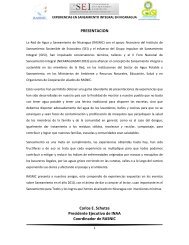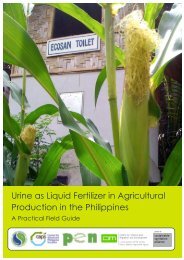Open Planning of Sanitation Systems
Open Planning of Sanitation Systems
Open Planning of Sanitation Systems
You also want an ePaper? Increase the reach of your titles
YUMPU automatically turns print PDFs into web optimized ePapers that Google loves.
<strong>Open</strong> <strong>Planning</strong> <strong>of</strong> <strong>Sanitation</strong> <strong>Systems</strong>Appendix 1: A Definition and Identification <strong>of</strong> Criteria for theSustainability <strong>of</strong> <strong>Sanitation</strong> <strong>Systems</strong> – 3rd DraftTo be published within the EcoSanRes 1 programmePatrick Bracken (GTZ), Anders Finnson (Stockholm Water Company), Elisabeth Kvarnström *(EcoSanRes), Erik Kärrman (Urban Water), Darren Saywell (WSSCC) and Alberto Ysunza(CECIPROC).* Contact person, address: VERNA Ecology, Inc; Malmgårdsvägen 14, 116 38 Stockholm, Sweden, e-mail: elisabeth@verna.se, phone #: +46-70-6178855BACKGROUNDThis working paper is the result <strong>of</strong> a three-day meeting held in Stockholm where sustainability inrelation to sanitation was discussed and an extensive list <strong>of</strong> criteria to meet sustainability in sanitationwas proposed. The organizations present at the meeting were• EcoSanRes, a Sida-funded environmental and development programme on ecological sanitation• Deutsche Gesellschaft für Technische Zusammenarbeit, GTZ• Centro de Capacitación Integral para Promotores Communitarios, CECIPROC in Mexico• Urban Water, a Swedish research programme on Sustainable Urban Water Management• Stockholm Water CompanyWater Supply and <strong>Sanitation</strong> Collaborative Council participated through written comments.SYSTEM BOUNDARY DEFINITIONAn additional, important consideration during the meeting was to identify what would be the appropriateboundaries <strong>of</strong> a sanitation system. This is <strong>of</strong> utmost importance when comparing different systems for aparticular context, and should be determined in such a way as to ensure that there is no export in eitherspace or time <strong>of</strong> problems that may be created by the system. It is reasonable to include at least the user<strong>of</strong> the system, the management <strong>of</strong> wastewater and its residual fractions, within the system boundaries.It is also possible, and even desirable, to include generation <strong>of</strong> nutrients and recovery <strong>of</strong> energy withinthe system boundaries.SUGGESTION OF CRITERIA TO CONSIDER FOR SANITATION SYSTEMS TO BESUSTAINABLEIt is impossible to identify a complete list <strong>of</strong> factors that will affect the sustainability <strong>of</strong> a sanitationsystem without knowing the specific context. Moreover, a list <strong>of</strong> criteria will not provide easy answers inthe decision-making process but it will help narrow down the discussion. The attempt here is therefore totry and present an extensive range <strong>of</strong> different criteria that might be <strong>of</strong> importance in different contexts.The list would need to be reduced/expanded for each specific case. There will also be a need to identifylocally relevant criteria that do not appear on this suggested list, irrespective <strong>of</strong> level <strong>of</strong> intervention,in close cooperation with all relevant stakeholders, the current legal framework and current cultural1 EcoSanRes (ecological sanitation research) is an international environment and development programme on ecologicalsanitation. It has its roots in the pioneering SanRes programme which ran from 1993 to 2002. It is sponsored by Sida,managed by Stockholm Environment Institute with Akkadia Environment, SwedEnviro and Vatema, and brings together aworld network <strong>of</strong> 20 organisations. For more information on the EcoSanRes programme, please consult www.ecosanres.org15



![Project Document [PDF: 2.31 MB] - EcoSanRes](https://img.yumpu.com/51279385/1/184x260/project-document-pdf-231-mb-ecosanres.jpg?quality=85)












![Latrines à compost [high-resolution colour PDF: 12.3MB] - EcoSanRes](https://img.yumpu.com/31726141/1/185x260/latrines-a-compost-high-resolution-colour-pdf-123mb-ecosanres.jpg?quality=85)